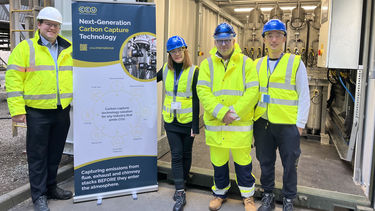Carbon dioxide from factory chimneys in the UK will this week start the journey towards being recycled into household detergent ingredients.
The innovation is part of a cross-sector collaboration to find an alternative raw material to virgin fossil fuel for many manufactured goods, from cosmetics to plastics. The Flue2Chem initiative will examine the potential for using valuable carbon dioxide emissions from industry as an alternative source of carbon.
5.3% of the world’s fossil fuel carbon is used to manufacture everyday materials and household products such as plastics, textiles and cleaning products.
17 organisations, including global manufacturers of fast-moving consumer goods (FMCGs), universities and innovation experts, are working together in this unprecedented collaboration. In this first step, the partners will examine the industrial-level transformation of carbon dioxide emissions from paper manufacturing into surfactants, contained in products such as dishwashing products, laundry products and paints.
The findings will inform industry and the Government about the feasibility of using non-virgin fossil fuel sources for many household and consumer products. The group will assess both the technical feasibility of the new and highly innovative processes, as well as the economic impacts of creating a new supply chain.
This week, the first carbon dioxide for the project will be captured at the Holmen Iggesund Paperboard Mill in Workington, Cumbria. The first batch of CO2 will be sent to specialist facilities at the University of Sheffield and CPI in Redcar, Teesside. There it will begin the first stage of the innovative processes to convert it into the chemical building blocks of surfactants.
Al Sanderson, Flue2Chem Project Manager, said: “For the last 14 months, we have been preparing for this moment. The chemical processes that will turn carbon dioxide into surfactants contained in many cleaning products have been identified and are being optimised.
“Each step is being closely measured so that we can understand the socio-economic and environmental impact of this new way to make common chemicals used in everyday products.
“This will support the design of potential future supply chains that could eliminate the need for virgin fossil carbon to make these product ingredients in future.”
Professor Peter Styring, Department of Chemical and Biological Engineering at the University of Sheffield, said: "It has been a great pleasure to work on the Flue2CHEM project with a wide range of industrial and academic experts in their field. The University of Sheffield developed the FluRefin capture technology way back in 2012 that is used to capture carbon dioxide from the raw flue gas from a biomass power plant, first at Holmen Iggesund Paper Mill in Cumbria, and later in the year at UPM in Irvine, Scotland. We have since done considerable R&D to the stage we are at now with its first installation at a working power plant. The award-winning technology is now being spun out by the university through the Edinburgh-registered CCU International Limited. The Innovate UK-funded Flue2CHEM project has allowed us to take the technology from sub-pilot to commercial scale in less than two years. This is the start of a long, but very exciting journey to help in the fight against climate change by developing a low-cost energy efficient CO2 capture system".
Carbon dioxide from paper manufacturing sites in Irvine, Scotland as well as Workington will be captured using technology developed by CCU International (CCUI), a technology spin-out business at the University of Sheffield. The pioneering technology was manufactured in Dewsbury, West Yorkshire.
Beena Sharma, CEO and Co-Founder of CCUI, said: "Capturing carbon dioxide and utilising it back into the industry supports a circular carbon economy and makes significant contributions to net-zero goals. This project highlights the importance of collaboration, and we look forward to deploying the technology in the coming months to a second emitter site in Scotland."
The Flue2Chem project could form the basis for the development of carbon harvesting on a commercial scale. As well as cutting emissions from manufacturing, it could reduce the need for oil and gas extraction in future to make detergent and other consumer products.
Flue2Chem Project Manager Al Sanderson added: “The Flue2Chem project exemplifies the power of global collaboration in addressing environmental challenges and moving towards a sustainable future.”

